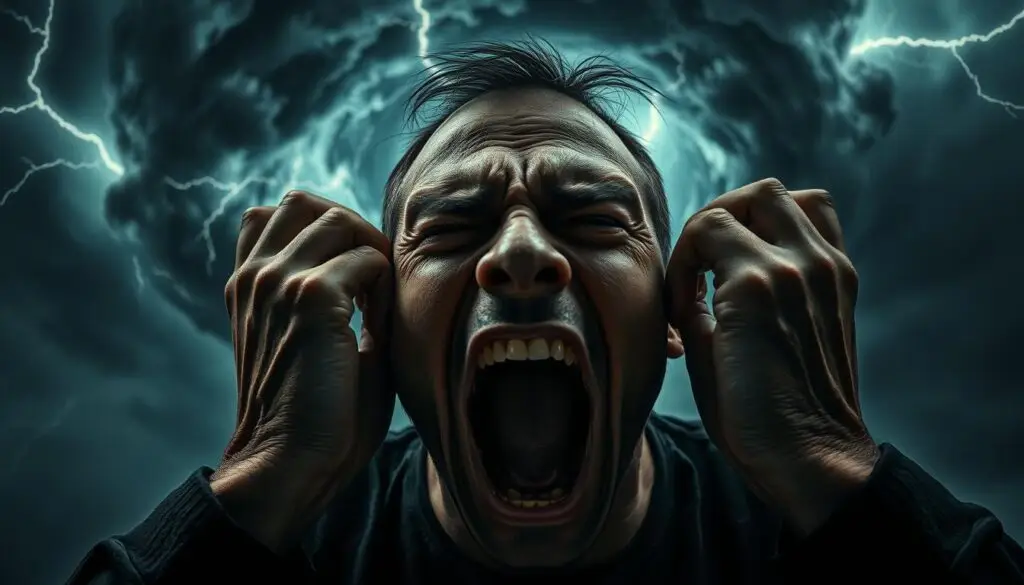You deserve clear answers when intense fear or constant worry starts to affect your life.
This article helps you tell when a sudden panic attack with chest pain, racing heart, breathlessness, or dizziness differs from longer‑lasting anxiety that builds around stressors.
Clinicians use the DSM-5-TR to name conditions like panic disorder and several anxiety disorders, not the informal term “anxiety attack.” That matters because a proper diagnosis guides effective care in the United States.
Read on to learn how symptoms, triggers, and duration separate sudden attacks from persistent worry, and to get practical steps you can use in the moment to regain control of your mental health.
Key Takeaways
- You’ll learn how sudden panic differs from gradual anxiety and why wording matters for diagnosis.
- Recognize common physical symptoms and how they affect daily health and performance.
- Understand DSM-5-TR categories so you can describe experiences accurately to a provider.
- Find brief, practical strategies to use during an episode to calm breathing and focus.
- Get clarity on next steps for evaluation, therapy options, and medical checks in the U.S.
Why understanding the difference matters for your mental health right now
Knowing which experience you’re facing lets you act faster.
You can tell anxiety and panic apart by how long they last. Anxiety can persist for days or weeks, while a panic attack often peaks in 5–20 minutes.
That timing matters because the best steps differ. Panic may come without a clear trigger, while anxiety tends to follow stress or ongoing worries.
- You reduce risk sooner by naming the issue and choosing targeted care.
- You avoid unnecessary ER trips when you spot acute signs and follow up with primary care or therapy for ongoing support.
- You protect work, relationships, and sleep by addressing patterns early.
| Feature | Typical timing | Common triggers | Usual next step |
|---|---|---|---|
| Panic | Peaks minutes | Often no clear trigger | Immediate calming; follow-up care |
| Anxiety | Days–weeks | Stressors, worry | Therapy, lifestyle changes |
| Overall impact | Variable | Both affect daily life | Early help improves outcomes |
What clinicians mean by panic attacks, anxiety, and disorders in the DSM-5-TR
The DSM-5-TR gives clinicians a clear framework so they can match your experience to a diagnostic label and plan effective care.
“Anxiety attack” isn’t a formal DSM term. Clinicians instead evaluate for named anxiety disorders such as generalized anxiety disorder, social anxiety disorder, specific phobia, separation anxiety, agoraphobia, and panic disorder.
That distinction matters because accurate wording helps your provider document symptoms and choose the right treatment path. Describe timing, triggers, and physical sensations so clinicians can decide whether you meet criteria for an anxiety disorder or another condition.
Expected vs. unexpected panic episodes
Panic attacks are flagged in the DSM-5-TR as expected when linked to a cue (a phobia or stressor) or unexpected when they come without warning.
Classic panic symptoms include intense fear, derealization, chest pain, shortness of breath, racing heart, dizziness, sweating, trembling, nausea, and numbness or tingling. Clinicians also rule out other health conditions, like thyroid problems or cardiac issues, that can mimic these symptoms.
- Use clinical language: describe triggers, duration, and physical signs.
- This helps determine whether you’re facing panic disorder, a generalized anxiety condition, or another disorder entirely.
Quick comparison: panic attack vs. anxiety symptoms at a glance
A side-by-side glance makes it easier to tell sudden episodes from longer, stress‑related worry.
Onset and intensity: Panic attacks often come suddenly and peak in minutes. You may feel sharp chest pain, shortness of breath, or shaking that feels overwhelming.
Build and persistence: Anxiety attacks and general anxiety usually grow over hours or days. Symptoms can range from mild restlessness to intense worry that drains focus and energy.
Onset, intensity, duration, and triggers
- Panic: abrupt start; intense physical symptoms; peaks in 5–20 minutes; may be expected or occur without warning.
- Anxiety: gradual rise; variable symptoms; can last days or weeks; often tied to stressors or ongoing pressure.
- Functional impact: panic can stop you in your tracks; anxiety erodes concentration and sleep over time.
| Feature | Panic | Anxiety |
|---|---|---|
| Onset | Come suddenly | Builds over time |
| Common pain/symptoms | Chest pain, breath changes | Tension, worry, restlessness |
| Typical duration | Minutes | Days–weeks |
Quick checklist: note when attacks start, how intense the symptoms are, and what, if anything, triggered them. That checklist helps your clinician decide next steps.
Recognizing symptoms of panic attacks you shouldn’t ignore
A sudden rush of intense physical symptoms deserves swift attention, because some episodes mimic serious medical issues.
Physical signs:
Racing heart, chest pain, breath trouble, dizziness
You may feel a pounding heart, tight chest pain, or shortness breath that makes breathing feel hard. These physical symptoms can resemble heart problems, so prompt medical rule-out is wise if you’re unsure.
Other common cues include sweating, trembling, nausea, chills or hot flashes, and numbness or tingling.
Emotional and cognitive signs:
Fear of dying, losing control, derealization
Intense fear often appears with feelings of unreality or detachment from yourself. You might fear dying or losing control, which fuels the physical surge and makes attacks feel worse.
Quick grounding and breathing moves can reduce breath stacking and help you re-center during an acute episode.
- Spot the pattern: repeated attacks that match this profile suggest a need for clinical evaluation.
- Act early: name the symptoms, seek medical clearance, then pursue targeted care if attacks recur.
How anxiety typically shows up and builds over time
You may notice worries stacking up day after day until they begin to drain your energy and attention.
Generalized anxiety often looks like steady tension rather than a sudden crisis. You might feel persistent worry, restlessness, and irritability that make it hard to concentrate.
Muscle tension and disrupted sleep are common symptoms. These signs usually follow ongoing stress at work, in relationships, or about health.
Generalized anxiety patterns: worry, restlessness, irritability, muscle tension
- Worry builds slowly and often covers many topics.
- Restlessness and trouble focusing sap daily productivity.
- Irritability and muscle tightness may last weeks or months if untreated.
- Generalized anxiety disorder can coexist with other mental health disorders and with panic attacks.
Over time, untreated anxiety can erode sleep and energy. Early recognition helps you seek care before problems worsen.
| Feature | How it builds | Usual impact over time |
|---|---|---|
| Worry | Persistent, multi-topic | Reduced focus and increased fatigue |
| Tension | Gradual muscle tightness | Pain, sleep disruption |
| Emotional | Irritability, low patience | Strained relationships |
Causes and triggers: what can set off panic vs. anxiety
Both sudden episodes and ongoing worry start with clear triggers you can learn to spot.
Some causes are obvious, like a known phobia that prompts a fast physical reaction. Other causes are hidden, such as medication effects or low thyroid function that raise baseline arousal. You can plan around many triggers once you name them.

Expected or unexpected episodes
Expected episodes tie to a clear cue—flying, heights, or crowded spaces. You can often prepare or use exposure strategies.
Unexpected episodes can come suddenly, even during sleep, with no obvious warning. These out-of-the-blue events feel more frightening because they seem to appear without cause.
Common anxiety drivers and substances that matter
You face many everyday stressors that raise chronic worry: work deadlines, relationship conflict, and health concerns. Chronic illnesses and chronic pain also increase vulnerability and may worsen symptoms.
- Caffeine and stimulant overuse can trigger or worsen attacks.
- Alcohol or drug withdrawal often spikes anxiety and can precipitate acute episodes.
- Some medications or supplements and thyroid problems mimic anxiety-like conditions, so check with your clinician.
- Trauma reminders can quickly amplify both panic and ongoing anxiety; plan safer exposure or avoidance.
Map your triggers. Track when episodes start, what you were doing, and any substances involved. That map helps you anticipate risks and de-escalate reactions before they grow.
Risk factors that raise your likelihood of attacks and disorders
Certain life events and long-term health issues raise the chance that you’ll face sudden attacks or chronic anxiety.
Personal and family history, chronic conditions, and life stressors
A family history of anxiety or panic disorder increases your personal risk and supports earlier screening. Trauma exposure and major life changes—loss, divorce, or financial strain—also tilt the balance toward more frequent episodes.
Chronic health conditions and depression raise baseline arousal. Substance use, including heavy caffeine or withdrawal from alcohol or drugs, can trigger attacks and complicate treatment.
Sex, gender patterns, and vulnerable populations
Women are roughly twice as likely as men to develop anxiety disorders. Sexual minorities face higher rates of generalized anxiety and panic experiences across age groups.
“Map your risk factors so you can plan prevention and seek help early.”
| Risk category | Examples | Action to take |
|---|---|---|
| Family history | Parent or sibling with anxiety | Ask for earlier screening |
| Life stressors | Loss, job strain, finances | Use short-term coping plan |
| Health & substance | Chronic illness, alcohol use | Coordinate care with providers |
Diagnosing the difference in the United States
When you seek care, clinicians focus on your story, not just a single symptom. Expect a focused visit where timing, triggers, and the ways episodes disrupt work or sleep guide the evaluation.
Clinical evaluation: history, psychological screening
Your clinician will take a detailed history and may use brief questionnaires to spot patterns that match panic, anxiety, or other disorders.
Be ready to describe onset, duration, and what you felt. Honest answers about daily function help shape next steps.
Ruling out health conditions: physical exam, bloodwork, EKG
If you report chest pain or palpitations, a physical exam plus blood tests and an EKG rule out other health conditions that mimic attacks.
Discuss current medication and any recreational drug use so your care team can avoid harmful interactions.
“A clear evaluation leaves you with a safe plan: therapy, medication, or both based on test results.”
- What to expect: your doctor may review onset, triggers, and impact.
- Screening helps: questionnaires can separate brief panic from ongoing anxiety patterns.
- Next step: after ruling out medical causes, a doctor may prescribe treatment tailored to your needs.
Treatment paths that work: therapy, skills, and medication
Effective care often pairs hands‑on psychotherapy with short skills practice and, when needed, medication.
Proven psychotherapies
Cognitive behavioral therapy (CBT), cognitive therapy, and exposure work to change patterns that feed both panic and anxiety. These approaches teach new responses so attacks occur less often.
Skills you can use now
Simple techniques—breathing exercises, progressive muscle relaxation, mindfulness, guided imagery, and biofeedback—downshift your nervous system in minutes.

Medication options a doctor may prescribe
For ongoing control, clinicians often recommend SSRIs or SNRIs. Beta‑blockers can reduce physical symptoms like rapid heart rate. Pregabalin may be considered if first‑line antidepressants don’t help.
Safety first
Benzodiazepines can relieve severe anxiety or sudden panic but carry dependence and withdrawal risks. The FDA boxed warning highlights those dangers, so these drugs are for short, closely monitored use.
“A combined plan—therapy, daily skills, and careful medication—gives you the best chance to reduce future attacks and improve daily life.”
- Next step: talk with your clinician about a plan that fits your goals and safety needs.
What to do during an episode: practical steps to regain control
A few focused steps can cut through intense fear and help your body relax within minutes.
Slow breathing and grounding to ease shortness and fear
Start with slow diaphragmatic breathing. Breathe in for four counts, then try a four-count exhale. Repeat until your heart and breath steady.
Ground with the senses: feel your feet, name five things you see, notice a nearby scent. These steps interrupt spirals and lower physical arousal.
Acknowledgment and present-moment focus to reduce panic spirals
Tell yourself, “This is a panic attack; it will pass.” Naming it reduces fear and shortens symptoms. Use guided imagery or progressive muscle relaxation to release tension.
Keep a pocket plan: a short script, a timer for breathing, and a checklist any person can follow when experiencing panic. Practice these techniques between episodes so they feel automatic during an attack.
“Simple, repeatable moves can move you from alarm to calm in minutes.”
Signs of Panic Disorder vs Anxiety Disorder
When intense episodes return without warning and you begin changing plans to avoid them, that pattern points to a clinical condition.
When repeated panic attacks point to panic disorder
If you have recurrent unexpected panic attacks and then worry about more, clinicians often consider panic disorder. You may start avoiding places or situations that you associate with past episodes.
Key cues: abrupt peaks, frequent panic attacks, and behavior change to reduce risk.
When persistent worry and tension indicate generalized anxiety disorder
When worry lasts months and comes with restlessness, muscle tension, or sleep trouble, the pattern fits generalized anxiety disorder. Symptoms build slowly and reduce daily functioning.
- Match your timeline: abrupt peaks suggest panic; long-running worry suggests generalized anxiety disorder.
- Describe specific symptoms panic attack history or persistent anxiety to your clinician for accurate diagnosis.
- Next steps: exposure-based work for panic-related avoidance; CBT and coping skills for generalized worry.
| Feature | Panic | Anxiety |
|---|---|---|
| Timeline | Minutes (sudden) | Weeks–months |
| Impact | Avoidance and acute fear | Chronic tension and fatigue |
| Usual treatment | Exposure therapy, short-term meds | CBT, lifestyle changes |
Lifestyle strategies to prevent and reduce future attacks
Changing everyday routines can lower baseline arousal and cut the odds of future attacks.
Build a steady daily routine. Move regularly, eat balanced meals, and keep consistent sleep times. These habits reduce chronic tension and boost long‑term health.
Practice meditation or yoga to calm your nervous system between episodes. Short, daily sessions improve focus and reduce overall anxiety.
Limit alcohol and caffeine. Cutting back prevents spikes that can trigger anxiety panic attacks or sudden panic episodes.
Add simple techniques—guided imagery, progressive relaxation, brief breathing drills—to your toolkit. Practice them when calm so they work quickly during an episode.
Lean on support. Join a peer group or talk to friends so you don’t navigate recovery alone. Shared strategies and encouragement sustain change.
“Small, consistent changes in work breaks, screen time, and movement build resilience and lower stress over time.”
- Set life rhythms: breaks, limits on screens, and regular meals.
- Use mindfulness and routine to reduce baseline arousal.
- Track triggers and tweak habits to protect your daily functioning.
When to seek professional help and how to get support
If attacks become frequent or your daily routine slips, it’s time to reach out for professional care.
Early evaluation improves outcomes. A licensed clinician can review your history and rule out medical causes. They will explain whether treatment should focus on therapy, medication, or a mix of both.
You’ll learn how to find a mental health provider and what to expect at the first visit. Most initial appointments cover symptoms, timing, and daily impact so your doctor may recommend tailored next steps.
When meds are part of care, ask about benefits, risks, and follow-up. The FDA warns about benzodiazepine risks, so safe use and a clear plan matter.
- Seek help if attacks recur, worry is constant, or work and sleep suffer.
- Use licensed therapists and primary care to coordinate care and monitor progress.
- Include a trusted person in your plan so you’re not facing episodes alone.
“Prioritize your mental health just as you would any other health concern—take the first step today.”
Conclusion
, Use what you’ve learned to act with confidence. You can spot when episodes come suddenly and peak in minutes versus when worry builds over time. That difference helps you pick the right immediate steps and long‑term care.
You now know how panic and anxiety feel in the body and mind. Note key symptoms, ground your breathing, and use quick tools so attacks lose intensity fast.
Talk with a clinician when episodes repeat. A doctor may review health conditions, suggest therapy, or recommend medication tailored to your needs, including for generalized anxiety or an anxiety disorder.
Take one practical step today—track episodes, share your plan with someone you trust, and schedule a check‑in so your life and health move toward steady relief.



